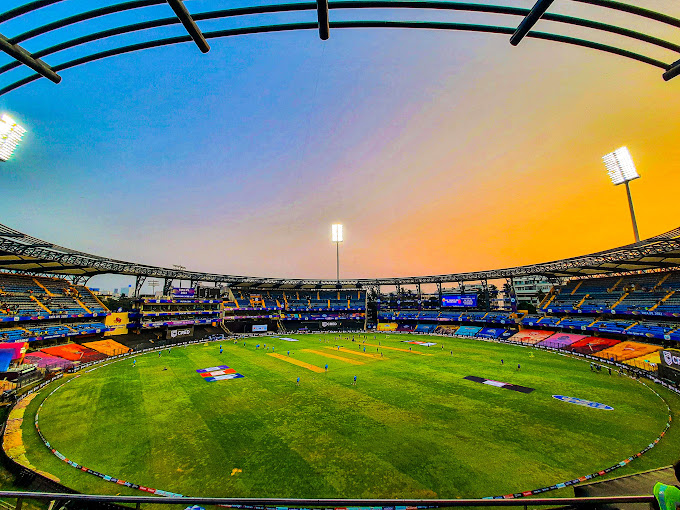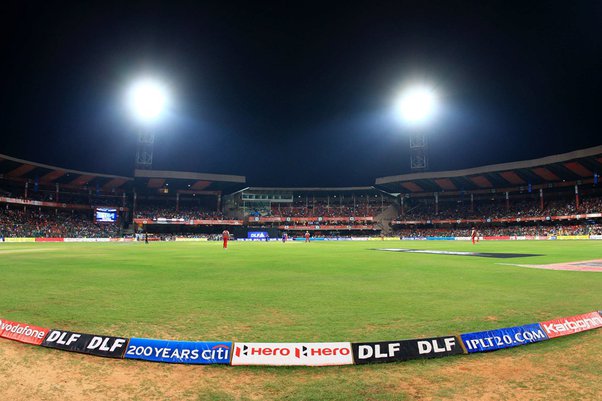This is a list of international cricket grounds in India that have hosted at least one international cricket match. A cricket ground is a large grass field on which the game of cricket is played which are generally oval in shape with no fixed dimensions. A boundary rope usually demarcates the perimeter of the field and a cricket pitch, an area close to the centre of the field is where the batter hits the bowled ball and run between the wickets to score runs, while the fielding team tries to return the ball to either wicket to prevent this.
India recorded its first win in fifth test of home series against England on 10 February 1952 at the M. A. Chidambaram Stadium in Madras. The first ODI match in India was hosted by the Sardar Vallabhbhai Patel Stadium, Ahmedabad during the series against England on 25 November 1981. India played the first T20I match in India at the Brabourne Stadium in Mumbai on 20 October 2007 against the visiting Australian team.

Wankhede Stadium is an international cricket stadium in Mumbai, India.[3] It is owned and operated by Mumbai Cricket Association (MCA) and is the home ground of the Mumbai Indians. It houses the headquarters of MCA, the Board of Control for Cricket in India (BCCI), and the Indian Premier League (IPL).
The stadium is situated near Marine Drive in the Churchgate neighbourhood. Several old cricket clubs are near the stadium, including Hindu Gymkhana, Parsi Gymkhana and Cricket Club of India (CCI).
The stadium has been host to numerous high-profile cricket matches in the past, most notably the 2011 Cricket World Cup Final, in which India defeated Sri Lanka and became the first country to win the Cricket World Cup on home soil. It hosted the last match of Sachin Tendulkar's international career.

M. A. Chidambaram Stadium, commonly known as the Chepauk Stadium, is a cricket stadium in Chennai, Tamil Nadu, India.[12] Established in 1916, it is the second oldest cricket stadium in the country after Eden Gardens in Kolkata.[4][13] It is owned and operated by Tamil Nadu Cricket Association (TNCA). The stadium is located at Chepauk, a few hundred meters from Marina beach along the Bay of Bengal.
Formerly known as Madras Cricket Club Ground, the stadium is named after Muthiah Annamalai Chidambaram, the former president of BCCI and Head of TNCA. It is the home ground of the Tamil Nadu cricket team and the Indian Premier League team Chennai Super Kings. Chepauk hosted its first Test match on 10 February 1934, hosted the first match of the first Ranji Trophy in 1934 and the Indian cricket team's first test victory in 1952 against England. The 1986 India-Australia match held at Chepauk was only the second ever Tied Test in the history of the game. The stadium hosted the finals of IPL 2011, IPL 2012, and IPL 2024.

Eden Gardens is an international cricket stadium in Kolkata, India. Established in 1864, it is the oldest and second-largest cricket stadium in India and third-largest in the world. The stadium currently has a capacity of 68,000.[7] It is owned and operated by Cricket Association of Bengal (CAB) and is the home ground of the Kolkata Knight Riders. It houses the headquarters of Cricket Association of Bengal.
Eden Gardens is often referred to as home of Indian cricket and has also been described as "cricket's answer to the Colosseum" and called the "Mecca of Indian cricket", due to it being the first purpose-built ground for the sport.[9][10] Eden Gardens has hosted matches in major international competitions including the World Cup, World Twenty20 and Asia Cup. In 1987, Eden Gardens became the second stadium to host a World Cup final. The 2016 ICC World Twenty20 final was held at the stadium, with the West Indies beating England in a closely fought encounter. Eden Gardens witnessed a record crowd of 110,564 in the 1996 India Vs Sri Lanka Cricket World Cup Semi Final.

The M. Chinnaswamy Stadium, also known as the Karnataka State Cricket Association Stadium,[3] is a cricket stadium in the Bangalore city of the Indian state of Karnataka. The ground is owned by Government of Karnataka and operated by Karnataka State Cricket Association (KSCA).
Flanked by the picturesque Cubbon Park, Queen's Road, Cubbon and uptown MG Road, this five-decade-old stadium is situated in the heart of the city of Bangalore. It regularly hosts Test, ODI, T20I and first-class cricket matches, as well as musical, cultural events. The stadium is the home ground of the Karnataka state cricket team, Karnataka women's cricket team and IPL franchise Royal Challengers Bangalore. It is owned by the Government of Karnataka and has been leased out to the KSCA for a period of 100 years.
Formerly known as the Karnataka State Cricket Association Stadium, it was later rechristened in tribute to Mangalam Chinnaswamy, a lawyer from Mandya and the founding member of the Mysore State Cricket Association. He served the KSCA for four decades and was also president of the Board of Control for Cricket in India (BCCI) from 1977 to 1980, latter's National Cricket Academy also situated in the premises of this stadium.
It is the first cricket stadium in the world to use solar panels to generate a bulk of the electricity needed to run the stadium. The panels were procured through the "Go Green" initiative of the KSCA. In 2016 a water purification plant was added, and by January 2017 a system of aeration and drainage was in place to avoid matches being curtailed due to a wet outfield.

The Narendra Modi Stadium (NMS), formerly known as Motera Stadium, is an international cricket stadium in Ahmedabad, Gujarat, India. It is the largest stadium in the world, with a seating capacity of 132,000 spectators. The stadium is owned by the Gujarat Cricket Association and serves as the venue for domestic and international cricket matches. It is one of the world's premier cricket stadiums.
The Narendra Modi stadium stands on the same plot where the Sardar Patel Stadium was present from 1982 to 2015, until its demolition. It served as the main venue of domestic and international cricket in the city till 2015. It hosted some matches during the 1987, 1996, and 2011 ICC World Cups.[16][17][18] The Gujarat Cricket Association (GCA) scrapped the Sardar Patel Stadium in 2015 to build a state of the art and the world's biggest cricket stadium. The Narendra Modi stadium is designed by Australia's design firm Populous and built by Larsen and Toubro. It took 5 years to build, at an estimated cost of ₹800 crore (US$96 million). The arena replaced the iconic Melbourne Cricket Ground as the world's largest cricket stadium. The headquarter of the GCA is located in its premises. The Narendra Modi stadium has 4 dressing rooms, 11 center pitches, and 2 practice grounds that can host practice as well as domestic matches etc.
On 24 February 2021, the Gujarat Cricket Association (GCA), named this newly built stadium as the Narendra Modi Stadium in honour of the current Prime Minister of India, Narendra Modi, who was the president of the GCA (2009-2014) and the chief minister of Gujarat (2001-2014). In 2021, the stadium was inaugurated by the president of India, Ram Nath Kovind, in an event he presided over.
It was first opened to the public in 2020 amid the Namaste Trump event, organized for president of the United States Donald Trump. On 24 February 2021, the Narendra Modi stadium hosted its first Test match, when home side India played against England, it was also its first day-night test game. On 29 September 2022, the opening ceremony of the 36th National games was held in the stadium.